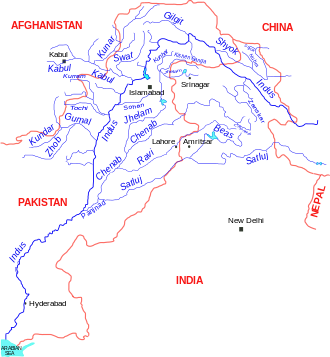| Zanskar River | |
|---|---|
 Zanskar River | |
 Map of the Indus River System - the Zanskar is a tributary of the Indus | |
| Location | |
| Country | India |
| State | Ladakh |
| Physical characteristics | |
| Mouth | |
• coordinates | 33°46′19″N76°50′43″E / 33.7719174°N 76.8453493°E |
| Basin features | |
| Progression | Indus→ Arabian Sea |
| River system | Indus River |
The Zanskar River is the first major tributary of the Indus River, equal or greater in volume than the main river,[ citation needed ] which flows entirely within Ladakh, India. It originates northeast of the Great Himalayan range and drains both the Himalayas and the Zanskar Range within the region of Zanskar. It flows northeast to join the Indus River near Nimo.

